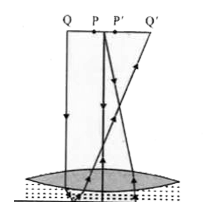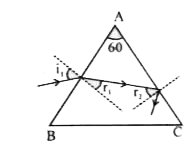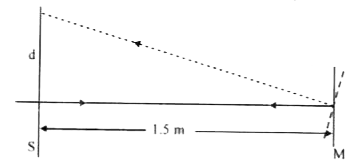SOLUTIONS TO EXERCISES FROM NCERT TEXT from NEW JYOTHI PHYSICS (TAMIL ENGLISH) RAY OPTICS AND OPTICAL INSTRUMENTS for Class 12
| Class 12 | PHYSICS |
| Chapter | RAY OPTICS AND OPTICAL INSTRUMENTS |
| NEW JYOTHI PHYSICS (TAMIL ENGLISH) | SOLUTIONS TO EXERCISES FROM NCERT TEXT |
| Medium | English |
| Academic Year | 2023-2024 |
Question 1
A small candle 2.5 cm in size is placed at 27 cm in front of a concave mirror of radius of corvature 36 cm. At what distance from the mirror should a screen be placed in order to obtain a sharp image? Describe the nature and size of the image. If the candle is moved closer to the mirror, how would the screen have to be moved ? View SolutionQuestion 3
A tank is filled with water to a heigth of 12.5 cm. The apparent depth of a needle lying at the bottom of the tank is measured by a microscope t be 9.4 cm. what is the refractive index of water ? If water is replaced by a liquid of refractive index 1.63 upto the same hight, by distance would the microscope have to be moved to focus on the needle again? View SolutionQuestion 11
A compound microscope consists of an objective lens of focal length 2.0 cm and an eyepiece of focal length 6.25 cm separated by a distance of 15 cm. How far from the objective should an object be placed in order to obtain the final image at (a) the least distance of distinct vision (25cm), and (b) at infinity? What is the magnifying power of the microscope in each case ? View SolutionQuestion 12
A person wit a normal near point (25 cm) using a compound microscope with objective of focal length 8.0 mm and an eyepiece of focal length 2.5 cm can bring object placed at 9.0 mm from the objective in sharp focus. What is the separation between the two lenses ? Calculate the magnifying power of the microscope. View SolutionQuestion 28
a. Determine the 'effective focl length ' of the combination of the two lenses in Exercise 9.10, if they are placed 8.0 cm apart with their principal axes coincident . Does the answer depend on which side of the combination a beam of parallel light is incident? in the notion of effective focal length of this system useful at all ? View SolutionQuestion 32
For a normal eye, the far point is at infinity and the near point of distanct vision is about 25 cm in front of the eye. The cornea of the eye provides a converging power of about 40 dioptres, and the least converging power of the eye-lens behind the cornea is about 20 dioptres. From this rough data estimate the range of accommodation (i.e., the range of converaging power of the eye-lens) of a normal eye. View SolutionQuestion 35
A man with normal near point (25 cm ) reads a book with small print using a magnifying glass : a thin convex lens of focal length 5 cm .
a What is the closest and the farthest distance at which he should keep the lens from the page so that can read the book when viewing through the magnifying glass ?
b. What is the maximum and the minimum angular magnification (magnifying power ) possible using the above simple microscope ? View SolutionQuestion 36
A card sheet divided into squares each of size 1 mm3 viewed at a distance of 9 cm through a magnifying glass (a converging lens of focal length 9 cm ) held close to the eye.
a. What is the magnification produced by lenas ? How much is the area of each square in the virtual image ?
b. What is the angular magnification (magnifying power ) of the lens ?
c. Is the magnification in (a) equal to the magnifying power in (b)? explain. View SolutionQuestion 47
A small telescope has an objective lens of focal length 140 cm and eyepiece of focal length 5.0 cm. What is the megniftying power of the telescope for viewing distant objects when
(a) the telescope is in normal adjustment (i.e, when the final image is at infinity )
(b) the final image is formed at the least distance of distinct vision (25cm) ? View SolutionQuestion 53
Figure shows an equiconvex lens (of refractive index 1.50 ) in contact with a liquid layer on top of a plane mirror. A small needle with its tip on the principal axis is moved along the axis until its inverted image is found at the position of the needle. The distance of the needle from the lens is measured to be 45.0 cm. The liquid is removed and the experiment is repeated . the new distance is measured to be 30.0 cm. What is the refractive index of the liquid ?
 View Solution
View Solution



